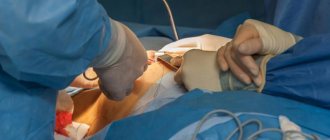How new is this operation?
Indeed, longitudinal (synonyms: reduction, sleeve, tubular, vertical) gastrectomy is a relatively new bariatric operation. I used the word “comparatively” because in fact, longitudinal gastrectomy (LG) is an integral part of the biliopancreatic bypass operation in the Hess-Marceau modification, known in the world since the early 1990s and successfully used in our clinic since 2003. Therefore, we can confidently say that the technical details of this operation have already been well worked out. However, as an independent operation, PRG was first performed in the USA in the early 2000s by M. Gagner et al. as the first stage of biliopancreatic bypass surgery in severely obese patients. The calculation was made to carry out the second, “intestinal stage” of biliopancreatic bypass, in the future, as the preliminary weight loss and improvement of the patients’ condition occurred. It later turned out that in some patients, PRJ turned out to be a completely self-sufficient operation to achieve the desired weight loss. Since that time, and this is only a little over five years ago, PRG began to be used in many foreign clinics, and then in our country, as an independent operation. In our clinic, prostate cancer was first performed as an independent operation in 2004.
Many patients are frightened by the phrase “gastric resection”. How justified are these fears?
Longitudinal gastrectomy is not at all the same resection that is performed for cancer or peptic ulcer disease. With PRG, the lateral part of the stomach is removed, while the important physiological valves of the stomach (cardiac sphincter and pylorus) are preserved, and thus the stomach after PRG remains physiologically quite functional. From a voluminous sac, the stomach turns into a narrow tube, where food does not stay long and quickly passes into the intestinal tract. The secretory activity of the stomach, of course, decreases, but this also plays into the hands of the goal of weight loss.
Ostomy care
It is quite possible for the patient to take care of the stoma at home. The ostomy hole is not a wound and does not require sterile conditions or sterile gloves.
Before changing the colostomy bag, check that everything is at hand. You will need:
- paper napkins, soft fabric non-sterile napkin;
- plastic bag for used colostomy bag;
- mirror (if the patient provides care himself);
- scissors for a hole in the plate;
- template (stencil) for determining the size of the stoma;
- soap;
- if necessary - non-sterile wipes, barrier paste and skin treatment products.
It is rational to care for your stoma in the evening, before bed. The colostomy bag should not be changed immediately after eating, as intensive separation of intestinal contents may begin.
The procedure for treating a stoma and replacing a colostomy bag:
- After washing your hands with soap, remove the used colostomy bag into a prepared bag and close it.
- Clean the stoma with a damp soft cloth. Wash your hands again.
- After which you can begin to cleanse the skin. It is enough to blot it with a soft towel. And, if possible, leave to dry for a few minutes. If there is a need to cut hair with scissors. Do not use razors or depilatory products as they cause irritation.
- Place the stencil on the stoma and trace the desired diameter with a pen.
- Cut a hole of the proper size in the adhesive sheet.
- If ulcers, wounds, or bleeding occur on the skin or intestinal mucosa, you should see your doctor. Remaining glue from the plate can be carefully wiped off with a napkin or use a special hypoallergenic leather cleaner.
- If there are unevenness or changes in skin texture, apply barrier paste around the stoma for better sealing and stick on a retainer plate.
- The choice of position of the bag for collecting intestinal contents depends on the patient’s activity - if he is constantly in bed, the bag should be oriented across the abdomen. In all other cases, the bottom of the bag should point down.
Important! To treat the skin, you cannot use products based on alcohol, ether, or aggressive antiseptic solutions.
An easy-to-care stoma is one that protrudes above the surface of the skin. In this case, it is easy to achieve tight coverage of the intestinal stump and a tight connection.
If the stoma is located in a recess and retracted, then so-called correctors are used - convex plates. They cover the intestinal stump using a tight flange. The concave shape of the products makes it possible to conveniently attach colostomy bags. For greater reliability, the plates are attached to the torso using a wide elastic band.
Photo: Convex plate, surface adjacent to the skin
In what situations can longitudinal gastrectomy be the operation of choice?
Longitudinal gastrectomy can be considered as the operation of choice in patients with relatively moderate excess weight (with a body mass index of 35 to 45), in patients with severe concomitant diseases, as well as in other situations when performing more complex operations is risky for one reason or another reasons. PRG can be offered to patients regardless of age, including adolescents and the elderly. In our country, gastric banding has proven itself well in cases where gastric banding did not produce the desired results.
Bariatric surgery for obesity
What is weight loss surgery (bariatric surgery)?
Weight loss surgery, sometimes called bariatric surgery, is a surgical treatment for overweight patients. These are operations to reduce the size of the stomach. Some types of surgery also change the path of nutrition through the intestines so that you take in fewer calories and nutrients.
Who gets bariatric surgery?
The surgeon uses a measurement called body mass index, or BMI, to determine who needs the surgery. Your body mass index will tell you whether your weight is normal for your height.
Bariatric surgery is only suitable for patients who are unable to lose weight using other methods and for those who:
has a BMI over 40; or
has a BMI between 35 and 40, and also has diseases such as diabetes, heart disease and hypertension.
Is there a difference between types of bariatric surgery?
Yes. There are different types of surgeries for obesity. Most commonly used:
Gastric banding - in this type of operation, the surgeon places an adjustable band on the upper part of the stomach, with the help of which the upper part of the stomach is reduced and this promotes rapid saturation, since the receptors signaling that the stomach is full are located in the upper part of the stomach. The doctor adjusts the cuff of the bandage to achieve a comfortable condition for the patient and, subsequently, the desired weight.
Gastric bypass (gastrobypass) - in this type of operation, the surgeon disconnects part of the stomach, leaving only a small area for food - the “small stomach”. It then connects the “small stomach” to the middle part of the small intestine. This results in food “bypassing,” or a short path for food to pass through.
Longitudinal (sleeve) gastrectomy (gastroplasty), or SLIV-1, is a type of operation that involves removing a large part of the stomach, and from the remaining part a tube, otherwise called a “sleeve,” is formed.
Gastric balloon placement is a temporary measure aimed at initial weight loss in hyperobese patients with severe underlying conditions to prepare them for full-blown surgery.
Currently, gastric banding is losing its popularity, and the most effective operations are considered to be longitudinal gastrectomy and gastric bypass.
How is bariatric surgery performed?
Various types of surgeries for obesity are performed in an “open” or “laparoscopic” manner. With the open method, the surgeon makes a large incision in the abdomen and directly works on the abdominal organs. During laparoscopic surgery, the surgeon enters the abdominal cavity to the organs using several punctures, and then inserts manipulative instruments through them. The manipulators are equipped with micro-instruments, lighting and a micro-camera, which allow operations to be carried out under visual control without making large incisions, which minimizes surgical tissue trauma and shortens rehabilitation time.
How do the different types of surgeries compare?
Gastrobypass (gastric bypass) leads to the greatest weight loss and works faster, but is the most serious operation with high risks, especially if recommendations are not followed in the postoperative period. After gastric bypass, there is a very high probability that type 2 diabetes mellitus will be completely eliminated. Gastrobypass surgery can cause a problem called malabsorption, which can lead to malabsorption and nutrient deficiencies and mean your body won't get enough of important nutrients. After gastric bypass surgery, your doctor will monitor your body's nutrient levels.
Longitudinal (sleeve) gastrectomy is a safer and less traumatic method than gastric bypass, because it is not associated with redirection of food transit through the gastrointestinal tract and with intestinal resection, resulting in fewer problems with absorption and nutritional deficiencies. This operation may even be safer than gastric banding since there is no foreign body in the body. The effectiveness of the operation is on average higher than with gastric banding.
Which surgery should I choose?
To decide which type of surgery is right for you, discuss all your options with your doctor. If you have multiple options, ask the following questions:
- How much weight can I lose using different types of surgery?
- how long will it take to lose weight?
- What are the risks with each type of surgery?
- What lifestyle changes and what diet should you follow after each type of surgery?
Whatever you decide, make sure that the surgeon who will operate on you has sufficient experience in performing bariatric surgery. Most hospitals that have experience with bariatric surgery offer patient lectures on obesity surgery, where you can learn more about the procedures and treatment options that are specific to you.
What are the benefits of bariatric surgery compared to non-surgical treatments for obesity and type 2 diabetes?
In addition to weight loss, in addition to helping you lose weight, surgery can help improve or even get rid of some health problems, including:
- Diabetes mellitus type 2
- Hypertonic disease
- Increased cholesterol levels
- Sleep apnea is a condition characterized by cessation of breathing (cessation of pulmonary ventilation) during sleep for more than 10 seconds;
- Gastroesophageal reflux disease, which constantly causes a feeling of heartburn.
What are the risks of the operation?
The risks of surgical treatment depend on:
- Choosing the type of weight loss surgery
- Method of operation: laparoscopic or open;
- Your age and presence of concomitant diseases;
- How experienced is the surgeon?
In general, risks may include:
- Bleeding;
- Infection or suppuration of postoperative wounds;
- Leakage of anastomoses or sutures on the stomach or intestines;
- Obstruction or perforation of the gastrointestinal tract;
- heart or lung problems;
- Formation of stones in the gallbladder;
- Eating problems;
- Diarrhea;
- The need to perform a repeat operation.
Do I need to change the way I eat?
Yes. It's important to work with a dietitian (nutrition expert) to find out how your diet needs to change.
You need to eat healthy foods before surgery. For example, you should choose foods that are high in protein and low in fat and calories. You should also avoid liquid foods that are high in calories, such as ice cream. If you eat the wrong foods, you can reduce your chances of losing weight.
If you have had gastric bypass surgery, you will need to avoid certain foods that may cause you to become obese again. In addition, you will need to take a special multivitamin with minerals on a regular basis. This is due to the fact that gastric bypass is accompanied by impaired absorption of nutrients in the gastrointestinal tract and leads to their deficiency throughout the body. You will need to take vitamins for the rest of your life. Your body will always need them to stay healthy.
Diagnosis and treatment of morbid obesity and diseases associated with metabolic syndrome should occur in a specialized department with the participation of a bariatric surgeon, endocrinologist, gastroenterologist and nutritionist.
Can PRG be considered as an alternative to, for example, gastric banding?
Yes, it is quite. Unlike gastric banding, gastric banding does not leave any foreign material (silicone) in the body. With PG, weight loss begins immediately after surgery, is completed earlier than after banding and does not depend on additional manipulations with the regulated system, but is actually determined by the new anatomy of the stomach. When performing gastric banding, the treatment result does not occur immediately, but only as the system fills, and in the future will depend on how the bandage system functions. Over time, the gastric band, like any equipment, may fail, require troubleshooting, or even replacement. With PRG this is impossible, because no implants are used here. Although, it must be admitted that the gastric banding operation is technically more complex and somewhat more risky than gastric banding. The operation can be performed either openly or laparoscopically. The length of hospital stay is 1-2 days longer than with banding.
Colostomy bags: what they are, their advantages and disadvantages
Whatever type of ostomy is performed on the patient, in any case, the stoma requires daily care and it must begin from the very first day after the operation. For hygienic purposes, colostomy bags have been created to collect contents from an artificial hole.
Conventionally, they can be divided into:
- disposable: two-component (conditionally reusable);
- one-component;
During use, the patient and those caring for him will gradually determine the preferences, availability and ease of use of certain colostomy bags.
What is the difference between PRJ and more complex operations?
Cholecystectomy
- Cost: 100,000 - 160,000 rubles.
- Duration: 25-30 minutes
- Hospitalization: 3 days in hospital
More details
A patient who has undergone pancreatic cancer usually does not require lifelong doses of vitamin and mineral supplements that are absolutely necessary after gastric bypass or biliopancreatic bypass. The likelihood of metabolic side effects (protein, vitamin and calcium deficiency) is also less here. PGC does not require removal of the gallbladder, although if gallstones form in the gallbladder during weight loss, this may be necessary later. At the same time, if we talk about the stability of weight loss, biliopancreatic bypass undoubtedly leads here. Due to the fact that the operation of prostate cancer is relatively young, no one can yet say how stable its results are after 5-10 or more years. Therefore, we warn all patients who are considering the option of longitudinal gastrectomy that if over time the result of PRG turns out to be insufficient, a second stage of treatment may be required - gastric bypass or biliopancreatic bypass. In this case, the second stage will be easier to complete, since the “gastric” stage of biliopancreatic bypass has actually already been completed.
The main pros and cons of various modifications of colostomy bags
Disposable colostomy bags
Single-component products are produced - a plate attached to the body and a receiving bag-container, which form one whole and are removed together as the bag is filled (up to half the volume).
Two-component colostomy bags consist of an adhesive-based plate and a replaceable bag. The plate is changed every 2-4 days. And the bag as it fills (up to half). The bag and the plate are firmly connected to each other using a flange.
Both receivers can be drainable or not.
Photo: Drainable one-component colostomy bag
Drainable bags have a channel (at the end opposite the attachment point) for discharging the contents. The drainage is closed with a clamp or other means. Through the drainage, as necessary, the contents of the collection are evacuated directly into the toilet, the hole is wiped and closed again with a clamp.
Photo: Non-drainable one-component colostomy bag
Pros:
- the flexible plate gives greater freedom
of movement to the patient, tightly adhering to the skin and ensuring odorlessness and confidence in fastening; - almost invisible under clothes
.
Minuses:
- more expensive to use (the cost of one product is from 100 rubles); the cost of use is also increased by the barrier paste for ostomy required for tightness (from 250 rubles);
- the adhesive base of the plate can cause irritation on the skin, despite the use of hypoallergenic compounds.
Reusable colostomy bags
There is also an option for containers for collecting intestinal contents. There are few similar offers in pharmacy chains and online stores.
Flaws:
- The main drawback of the design is its “unreliability”. A non-flexible ring with eyes is used. It is fixed to the body by pressing with an elastic band. The ribbon is worn around the torso. When changing body position (tilting, turning the body), leakage of the ring to the skin may occur. This causes the contents of the container to leak and produce an unpleasant odor. The solution in some situations is specially designed overlay plates that prevent excessive movement and maintain the stability of the connection.
- Another issue that confuses patients is its considerable size. The ring and the elastic band that holds it in place may be visible under clothing.
Advantages:
- Reusable colostomy bags are cheaper to use, since the main component of the product is used for a long time and repeatedly. Can be subjected to hygienic treatment (washing, sterilization). Only polymer bags with a ZIP clamp are regularly replaced with new ones; their cost is relatively low (20-40 rubles).
Photo: Reusable colostomy bag with fixing tape
Are postoperative complications possible? What is their probability?
It is impossible to guarantee the absence of complications with any operation. In case of prostate cancer, a staple suture is placed along the entire stomach. Although these sutures are performed using high-quality staplers and are always reinforced, there is still a small risk of postoperative bleeding, as well as failure (cutting through) of some sutures, which in rare cases may require laparoscopic or surgical revision. To prevent suture insufficiency in the first two weeks after prostate cancer, nutrition should be in liquid form, without undue stress on the gastric sutures. Since the operation takes place in the area of the splenic hilum, we always warn that if significant bleeding occurs from the spleen, it may be removed. We also warn about this during other gastric surgeries performed due to obesity.
How likely is heartburn (reflux - esophagitis) to occur after prostate cancer? How to deal with this?
Firstly, the probability of reflux of stomach contents into the esophagus largely depends on the volume of resection, i.e. the larger part of the stomach is removed and the more the stomach looks like a narrow tube, the less the danger of reflux of gastric contents into the esophagus. Secondly, reflux esophagitis can be effectively treated and prevented with the help of antiulcer drugs (omez, quamatel, ranitidine, pariet, etc.) that inhibit gastric secretion. Such treatment can be prescribed for a period of 2 - 3 months after surgery, and then only if necessary. We are not proponents of additional “anti-reflux” interventions. They are justified only when it comes to large diaphragmatic hernias.
What is a stoma after intestinal surgery?
A patient's ostomy is a necessary measure to create the opportunity to have a bowel movement. It is used for many surgical interventions:
- after removal of intestinal tumors;
- during reconstructive operations, for faster healing of intestinal sutures and anastomoses;
- in some cases with peritonitis (after trauma, wounds, colitis, diverticulitis, etc.);
- with acute intestinal obstruction, which developed as a complication of cancer, inflammatory processes in the intestine;
- for chronic inflammatory bowel diseases - nonspecific ulcerative colitis, Crohn's disease, ischemic colitis.











